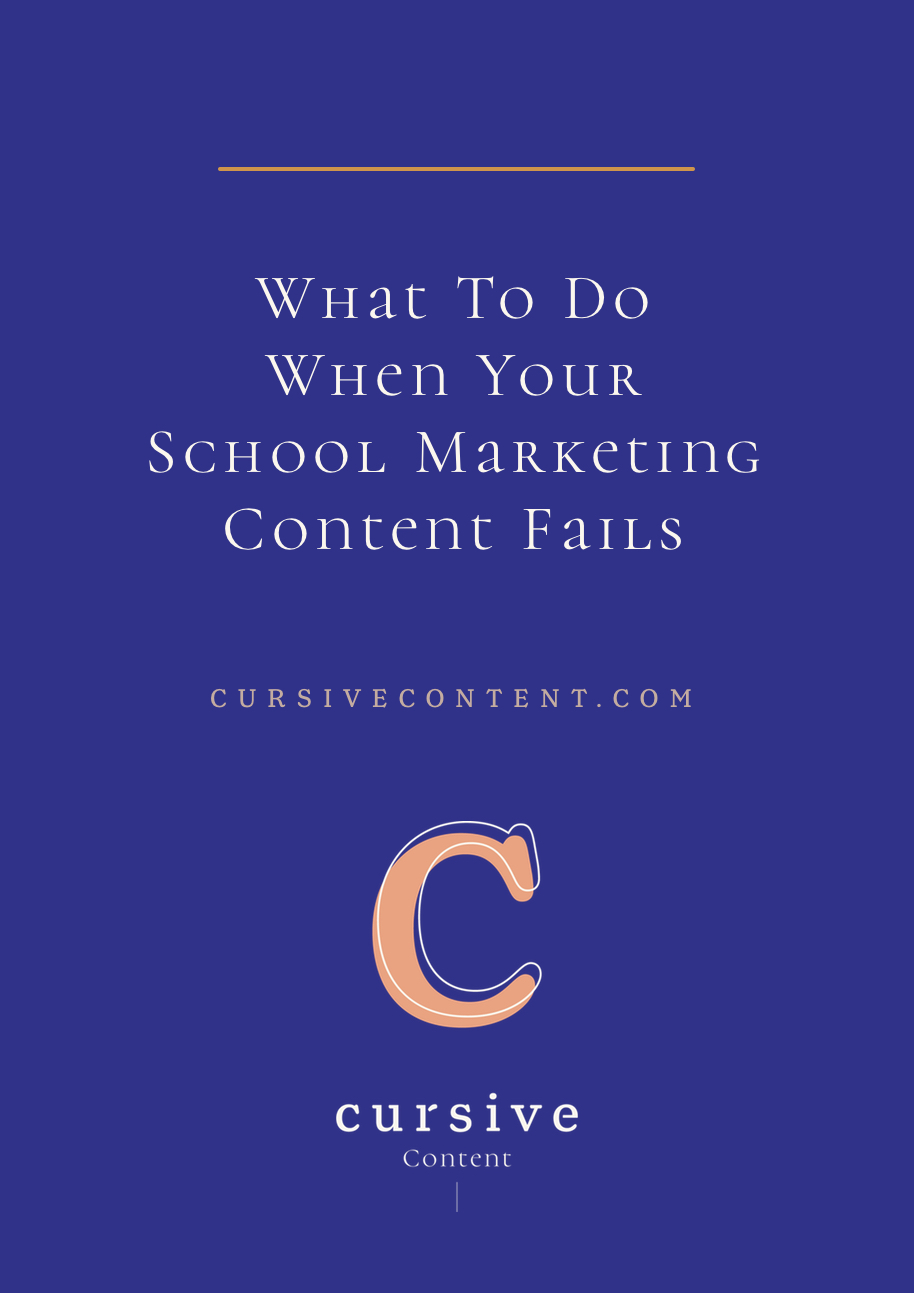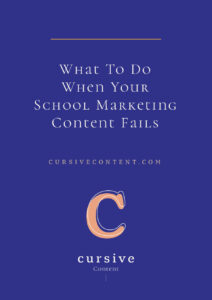What to do When Your School Marketing Content Fails

You work hard to create great content for your school. You’re savvy, smart and strategic. So when your school marketing project isn’t received with enthusiasm, doesn’t generate the leads you hoped, and just can’t seem to gain momentum, it’s okay to get frustrated.
After the frustration fades, though: get curious.
When your school marketing content doesn’t go as planned, it’s important to reflect on why it happened. Understanding why is the first step towards future success.
Here are 10 questions to ask yourself when you’re facing a content fail:
1. Have I given my content enough time to make an impact?
We all want to see instant results, but the days and even weeks following the release of new content are often not enough to gauge success. Don’t declare your new content a failure if it doesn’t immediately deliver the result you’d hoped.
In a world where so many marketers long to create “viral” content, it’s still true that often time is needed for word to spread, for more people to discover your content, for traction to grow. While viral can be exciting, it often fades fast. Long-term success is most often attributable to things you can’t fake, force or fast-forward, like hard work, dedication and consistency.
When your goal is to create standout school marketing, you have to be prepared to play the long game.
2. How have I promoted this content? Should I have done more or promoted it differently?
Your new blog might not see major traffic until you’ve given yourself time to promote it and given people time to discover it. You might need time to find a groove with that new weekly email.
If traffic, clicks, downloads or registrations aren’t meeting your goals: promote, promote, promote.
3. Does this piece have a compelling story?
If your audience doesn’t understand what the content is about, and you haven’t given them a compelling reason to click/read/watch/listen, chances are that they won’t.
Tell them a great story that connects and they’ll want to know more.
4. Is the content easy to find?
If you’ve buried your content deep within your website, give it a more high-profile presence. If your emails aren’t being opened, try sending them on a different day when your audiences’ inbox might be less crowded.
You don’t want your audience to have to work hard to find the amazing content you created. Make sure it’s easy.
5. Does this piece fit within my overall content strategy?
You took the time to create a content strategy for a reason: because it factors in the strengths of your school, the ways you stand apart from the competition, and the topics that matter to your audience. All of the content you create should fit your content strategy; if it doesn’t, it’s time to reimagine that content.
6. Does it speak to my audience?
You have to put aside your school’s internal agenda and create what your audience wants. If you haven’t touched on a topic that matters to your audience, they won’t care—even if that topic really matters to your school.
Check your content for the right tone, as well: it should be authentic to your school and relevant to your audience and the content format (a script for a video geared towards prospective students will be slightly different than the copy in a brochure for parents, for example).
7. Is it well-written/produced?
It’s so easy to create high quality content in all formats (audio, video, visuals, copy) thanks to the ease of smartphones and cameras, access to technology, and low cost of professional stock photos. Everyone from big brands to teenage YouTubers are creating high quality content—and your audience is used to seeing that content.
What does this mean for schools? It means that it really shows when you haven’t paid attention to the details. High quality doesn’t have to mean big budget, so there are no excuses for low quality.
8. Would this content work better in a different format?
If you’re truly finding that your content isn’t measuring up, consider the format. Would that brochure content be enhanced by a corresponding video? Could you repurpose that podcast episode into a blog post?
9. How am I judging success, and is that measurement realistic?
If you think your content has failed, consider why. Hopefully, you identified a goal for your content before the project began—measure your results based on that. Gather the metrics and compare against past content benchmarks to ground your expectations.
10. If I could create this piece again, what would I do differently?
Don’t hesitate to critique yourself. When a project goes awry, it can make a great learning experience. This isn’t about blame or criticism, but an honest evaluation of your missteps. When you know better, you can do better.
There is no fool-proof approach to school marketing. No one right answer, no magic solution. Even the best strategies will need adjustment. Even outstanding content takes time to make an impact. Not every piece of school marketing you create will be a raging success.
It’s how you respond to those failures that matters; you can throw your hands up and abandon your commitment to school storytelling, or use the experience to create better content.
If standout school storytelling is your goal, Cursive can help. Schedule a discovery call with us today.
MORE ARTICLES
-
 Clarity in 50 Words or Less: How to Write Your School’s One-Sentence Story
Clarity in 50 Words or Less: How to Write Your School’s One-Sentence Story -
 What Should Your School Do with Its Blog Now That AI Is Changing Search?
What Should Your School Do with Its Blog Now That AI Is Changing Search? -
 What Is Your Private School’s Bold & Unifying Big Promise?
What Is Your Private School’s Bold & Unifying Big Promise? -
 AI Writing Prompts to Power Private School Storytelling
AI Writing Prompts to Power Private School Storytelling -
 When to Outsource Your Private School Content Marketing to an Expert
When to Outsource Your Private School Content Marketing to an Expert -
 3 Unique Ways to Attract Dream Families with Content
3 Unique Ways to Attract Dream Families with Content -
 4 Quick & Easy Ways to Improve Your School’s Emails
4 Quick & Easy Ways to Improve Your School’s Emails -
 The Best Content Marketing Resources for Independent Schools
The Best Content Marketing Resources for Independent Schools


This would also be a great guideline even before your content “fails.” It would be a good practice to check if your content is up to these standards before it gets published. Thanks for this well-thought-out article.
Great point, Renee!